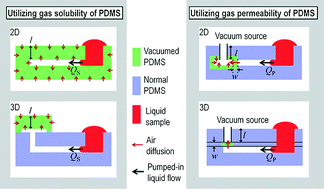Vacuum-driven power-free microfluidics utilizing the gas solubility or permeability of polydimethylsiloxane (PDMS)
Abstract
Suitable pumping methods for flow control remain a major technical hurdle in the path of biomedical microfluidic systems for point-of-care (POC) diagnostics. A vacuum-driven power-free micropumping method provides a promising solution to such a challenge. In this review, we focus on vacuum-driven power-free microfluidics based on the gas solubility or permeability of polydimethylsiloxane (PDMS); degassed PDMS can restore air inside itself due to its high gas solubility or gas permeable nature. PDMS allows the transfer of air into a vacuum through it due to its high gas permeability. Therefore, it is possible to store or transfer air into or through the gas soluble or permeable PDMS in order to withdraw liquids into the embedded dead-end microfluidic channels. This article provides a comprehensive look at the physics of the gas solubility and permeability of PDMS, a systematic review of different types of vacuum-driven power-free microfluidics, and guidelines for designing solubility-based or permeability-based PDMS devices, alongside existing applications. Advanced topics and the outlook in using micropumping that utilizes the gas solubility or permeability of PDMS will be also discussed. We strongly recommend that microfluidics and lab-on-chip (LOC) communities harness vacuum energy to develop smart vacuum-driven microfluidic systems.


 Please wait while we load your content...
Please wait while we load your content...